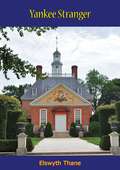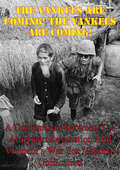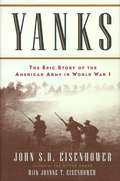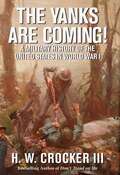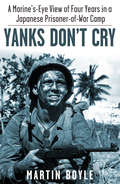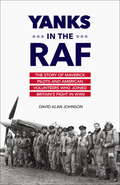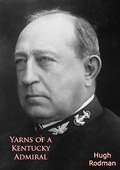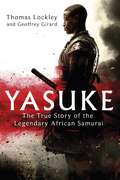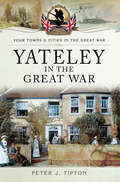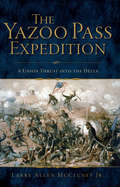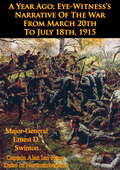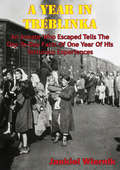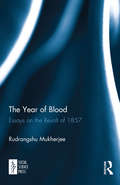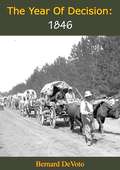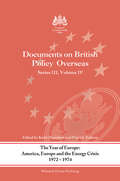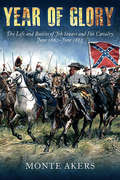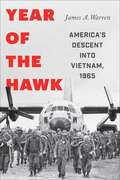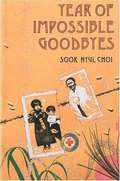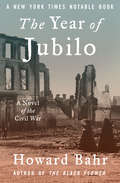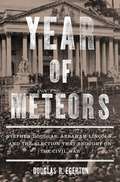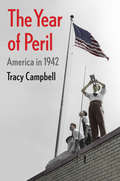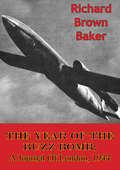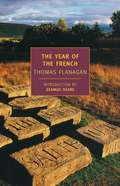- Table View
- List View
Yankee Stranger (The\williamsburg Novels Ser. #2)
by Elswyth ThaneLOVE AND WARCabot Murray first came to Williamsburg, Virginia, in the tense autumn of 1860. He was looked upon with suspicion because he was a Yankee. Then Cabot met redheaded Eden Day.Theirs was a wild, blind young love at first sight. Whispering in her hair, what did it matter that he was a Northerner and she from the South…But then came the Civil War. With the tide of battle Cabot returned as an enemy spy. In Eden he found the hatred of a woman who has learned desire.Could the bitterness of war be softened in the arms of lovers?
The Yankees are Coming! The Yankees are Coming!: A Comparison Between The American Revolution And Vietnam’s War For National Unification
by Major Jeffrey M. Dunn USMCThis paper compares British involvement in America's struggle for independence in the late eighteenth century with the United States' immersion in North Vietnam's struggle for national unification in the twentieth.Many similarities exist between the American Revolution and the Vietnam War. Five of the most apparent similarities are examined. First, Great Britain and the United States made similar fundamental assumptions, in their respective conflicts, which proved equally flawed. Second, the distances between the combatants in both conflicts were vast. The lines of communication were extremely long. Third, similarities abound between the people involved, both generally and specifically. Fourth, both wars have a single campaign that can be described as the turning point. Though Saratoga and Tet occurred at relatively early stages in the respective conflicts, the outcomes of the wars were arguably decided after those campaigns. Fifth, the southern strategies in both wars are remarkably analogous. Both Great Britain and the United States succeeded in alienating the undecided, and arousing animosity among the common people.1. The United States became the oppressor in Vietnam, and closely emulated its enemy, Great Britain, in the Revolutionary War.2. Many patterns repeat themselves through history and within those patterns are keys to success in the future.3. The United States needs to become more proficient at searching for patterns in history (not just its own). By learning from the mistakes made by itself and others, the U.S. will make fewer mistakes in the future.
Yanks
by John EisenhowerFought far from home, World War I was nonetheless a stirring American adventure. The achievements of the United States during that war, often underrated by military historians, were in fact remarkable, and they turned the tide of the conflict. So says John S. D. Eisenhower, one of today's most acclaimed military historians, in his sweeping history of the Great War and the men who won it: the Yanks of the American Expeditionary Force. Their men dying in droves on the stalemated Western Front, British and French generals complained that America was giving too little, too late. John Eisenhower shows why they were wrong. The European Allies wished to plug the much-needed U.S. troops into their armies in order to fill the gaps in the line. But General John J. "Black Jack" Pershing, the indomitable commander of the AEF, determined that its troops would fight together, as a whole, in a truly American army. Only this force, he argued -- not bolstered French or British units -- could convince Germany that it was hopeless to fight on. Pershing's often-criticized decision led to the beginning of the end of World War I -- and the beginning of the U.S. Army as it is known today. The United States started the war with 200,000 troops, including the National Guard as well as regulars. They were men principally trained to fight Indians and Mexicans. Just nineteen months later the Army had mobilized, trained, and equipped four million men and shipped two million of them to France. It was the greatest mobilization of military forces the New World had yet seen. For the men it was a baptism of fire. Throughout Yanks Eisenhower focuses on the small but expert cadre of officers who directed our effort: not only Pershing, but also the men who would win their lasting fame in a later war -- MacArthur, Patton, and Marshall. But the author has mined diaries, memoirs, and after-action reports to resurrect as well the doughboys in the trenches, the unknown soldiers who made every advance possible and suffered most for every defeat. He brings vividly to life those men who achieved prominence as the AEF and its allies drove the Germans back into their homeland -- the irreverent diarist Maury Maverick, Charles W. Whittlesey and his famous "lost battalion," the colorful Colonel Ulysses Grant McAlexander, and Sergeant Alvin C. York, who became an instant celebrity by singlehandedly taking 132 Germans as prisoners. From outposts in dusty, inglorious American backwaters to the final bloody drive across Europe, Yanks illuminates America's Great War as though for the first time. In the AEF, General John J. Pershing created the Army that would make ours the American age; in Yanks that Army has at last found a storyteller worthy of its deeds.
The Yanks Are Coming!: A Military History of the United States in World War I
by H. W. Crocker IIIBestselling military historian H. W. Crocker III (The Politically Incorrect Guide to the Civil War, Robert E. Lee on Leadership, etc.) now turns his guns on the epic story of America's involvement in the First World War with his new book The Yanks Are Coming: A Military History of the United States in World War I. <P><P>2014 marks the centenary of the beginning of that war, and in Crocker's sweeping, American-focused account, readers will learn: <P><P>How George S. Patton, Douglas MacArthur, George C. Marshall (of the Marshall Plan), "Wild Bill" Donovan (future founder of the OSS, the World War II precursor to the CIA), Harry S. Truman, and many other American heroes earned their military spurs in "The Great War" <P><P>Why, despite the efforts of the almost absurdly pacifistic administration of Woodrow Wilson, American involvement in the war was inevitable <P><P>How the First World War was "the War that Made the Modern World"-sweeping away most of the crowned heads of Europe, redrawing the map of the Middle East, setting the stage for the rise of communism and fascism <P><P>Why the First World War marked America's transition from a frontier power-some of our World War I generals had actually fought Indians-to a global superpower, with World War I generals like Douglas MacArthur living to see, and help shape, the nuclear age <P><P>"The Young Lions of the War" -- heroes who should not be forgotten, like air ace Eddie Rickenbacker, Sergeant Alvin York (memorably portrayed by Gary Cooper in the Academy Award-winning movie Sergeant York), and all four of Theodore Roosevelt's sons (one of whom was killed)Stirring, and full of brilliantly told stories of men at war, The Yanks Are Coming will be the essential book for readers interested in rediscovering America's role in the First World War on its hundredth anniversary.
The Yanks Are Coming: The United States in the First World War
by Albert MarrinDescribes how American military forces helped the Allies turn the tide of World War I and how the United States mobilized industry, trained soldiers, and promoted the war to the people at home.
Yanks Don't Cry
by Martin BoyleYanks Don't Cry, first published in 1963, opens on the tropical Pacific island of Guam in early December, 1941, a few short days before the attack on Pearl Harbor. The U.S. Marines on Guam, neither equipped nor prepared for an invasion are quickly captured and shipped off to prison in Japan. There they began a nearly four-year imprisonment until the war's end in 1945. During those years they managed to retain the high spirits of free men, to sabotage the Japanese war effort at every opportunity as they worked on the docks and in other areas, to steal extra food rations, and, near war's end, to observe with pride the American bombing raids on Japan (while struggling mightily to free a group of Japanese schoolchildren trapped in a warehouse damaged by the bombs). The author's sense-of-humor shines through on nearly every page, which allowed him and his companions a small measure of comfort and the strength to somehow carry on. Yanks Don't Cry remains a classic recounting of life in war-time Japan for Allied prisoners-of-war.
Yanks in the RAF
by David Alan JohnsonThis is the story of American volunteer pilots who risked their lives in defense of Britain during the earliest days of World War II--more than a year before Pearl Harbor, when the United States first became embroiled in the global conflict. Based on interviews, diaries, personal documents, and research in British, American, and German archives, the author has created a colorful portrait of this small group who were our nation's first combatants in World War II.As the author's research shows, their motives were various: some were idealistic; others were simply restless and looking for adventure. And though the British air force needed pilots, cultural conflicts between the raw American recruits and their reserved British commanders soon became evident. Prejudices on both sides and lack of communication had to be overcome. Eventually, the American pilots were assembled into three squadrons known as the Eagle squadrons. They saw action and suffered casualties in both England and France, notably in the attack on Dieppe. By September 1942, after America had entered the war, these now experienced pilots were transferred to the US air force, bringing their expertise and their British Spitfires with them.As much social as military history, Yanks in the RAF sheds new light on a little-known chapter of World War II and the earliest days of the sometimes fractious British-American alliance.From the Hardcover edition.
Yarns of a Kentucky Admiral
by Hugh RodmanHugh Rodman, a graduate of the Naval Academy, Class of 1880, is best known as the commander of the U.S. Navy's Battleship Division 9, that served in the North Sea in World War I as Battle Squadron 6, an integral part of the British Grand Fleet; after the war he was Commander-in‑Chief of the U. S. Navy's Pacific Fleet.
Yasuke: The true story of the legendary African Samurai
by Thomas Lockley Geoffrey GirardWARRIOR. SAMURAI. LEGEND.The remarkable life of history's first foreign-born samurai, and his astonishing journey from Northeast Africa to the heights of Japanese society.The man who came to be known as Yasuke arrived in Japan in the 16th century, an indentured mercenary arriving upon one of the Portuguese ships carrying a new language, a new religion and an introduction to the slave trade. Curiously tall, bald, massively built and black skinned, he was known as a steadfast bodyguard of immense strength and stature, and swiftly captured the interest, and thence the trust, of the most powerful family in all of Japan. Two years later, he vanished.Yasuke is the story of a legend that still captures the imagination of people across the world. It brings to life a little known side of Japan - a gripping narrative about an extraordinary figure in a fascinating time and place.
Yateley in the Great War (Your Towns & Cities in the Great War)
by Peter J. TiptonThere were fewer than 500 houses in Yateley in WWI but with Aldershot, Farnborough, Camberley and Sandhurst close by, this Hampshire villages response to the call to arms was more prepared than most, and punched above its weight.Using contemporary evidence from many sources researched by our local history team, the Yateley Society recreates the impact of the War on our predecessors. The story of the men who left Yateley to fight -- territorials, regulars, volunteers and conscripts -- is told alongside that of the battalions of Kitcheners New Armies training in trench warfare on Yateley Common. At the same time, in the three private houses forming the Yateley Military Hospital, Yateley women of all ages were tending wounded soldiers.With its intimate glimpses into village life, this book, will fascinate anyone with Yateley connections. The names of many families in the village of 100 years ago are here, while for recent newcomers with perhaps a Victorian or Edwardian house there may be clues to the history of your homes.With its many illustrations and maps, this exploration of the social network, and social consequences of the Great War on a small community in North East Hampshire has interest for historians and general readers alike.
Yazoo Pass Expedition, The: A Union Thrust into the Delta (Civil War Series)
by Larry Allen Jr.After six failed attempts to reach Vicksburg, General Ulysses S. Grant developed a plan. The Yazoo Pass Expedition was a Union army/navy operation meant to bypass Vicksburg by using the backwaters of the Mississippi Delta. Operations began on February 3, 1863, with a levee breach on the Mississippi River. The expedition was delayed as a result of natural obstacles and Confederate resistance, which allowed the Confederate army under Lieutenant General John Pemberton to block passage of the Federal fleet. The Confederates continued to rebuff the fleet and finally defeated it in the spring. Larry McCluney examines the expedition from start to finish in never-before-seen detail.
A Year Ago; Eye-Witness’s Narrative Of The War From March 20th To July 18th, 1915 [Illustrated Edition]
by Major-General Ernest D. Swinton Captain Alan Ian Percy Duke of NorthumberlandIncludes The First World War On The Western Front 1914-1915 Illustrations Pack with 101 maps, plans, and photos.Major-General Ernest Swinton had already had a long and illustrious career in the British Army before the advent of the First World War in 1914. Appointed as the official war correspondent by the war Minister Lord Kitchener in 1914, his reporting home was the only way for the British people to follow the war as journalists were at that time banned at the front. In these dispatches from the front Swinton told the public of the bloody fighting in Flanders and the heroic efforts of the Allies to stop the German Juggernaut. So even handed and realistic they were brought together in a series of books under the pseudonym "Eyewitness" for further publication. Swinton was not a "château" general by any means and visited the front with dangerous regularity write of the fighting with real authority, often including anecdotes of the ordinary soldiers that he interviewed. The miserable conditions and bloody siege warfare of the trenches left a lasting impression on him and he looked to a scientific solution to the muddy stalemate of the Western Front. He would gain lasting fame as the architect of the "tank" project that was to revolutionize warfare in the First World War and for many years thereafter.
Year in Nam: A Native American Soldier's Story
by Leroy TecubeRecollections from a Native American about the year that he spent in Vietnam during the Vietnam War, and how it influenced him throughout his life
A Year In Treblinka
by Jankiel WiernikAn Inmate Who Escaped Tells The Day-To-Day Facts Of One Year Of His Torturous Experiences.Jankiel Wiernik was a Jewish property manager in Warsaw when the Nazis invaded Poland and was forced into the ghetto in 1940. Despite surviving the horrors of the ghetto at the advanced age of 52, he was sent to a fate worse than death at the notorious death camp at Treblinka, which he immortalized in his memoirs."On his arrival at Treblinka aboard the Holocaust train from Warsaw, Wiernik was selected to work rather than be immediately killed. Wiernik's first job with the Sonderkommando required him to drag corpses from the gas chambers to mass graves. Wienik was traumatized by his experiences. He later wrote in his book: "It often happened that an arm or a leg fell off when we tied straps around them in order to drag the bodies away." He remembered the horrors of the enormous pyres, where "10,000 to 12,000 corpses were cremated at one time." He wrote: "The bodies of women were used for kindling" while Germans "toasted the scene with brandy and with the choicest liqueurs, ate, caroused and had a great time warming themselves by the fire." Wiernik described small children awaiting so long in the cold for their turn in the gas chambers that "their feet froze and stuck to the icy ground" and noted one guard who would "frequently snatch a child from the woman's arms and either tear the child in half or grab it by the legs, smash its head against a wall and throw the body away." At other times "children were snatched from their mothers' arms and tossed into the flames alive." "Wiernik escaped Treblinka during the revolt of the prisoners on "a sizzling hot day" of August 2, 1943. A shot fired into the air signalled that the revolt was on. Wiernik wrote that he "grabbed some guns" and, after spotting an opportunity to make a break for the woods, an axe..."
The Year of Blood: Essays on the Revolt of 1857
by Rudrangshu MukherjeeRudrangshu Mukherjee places the ‘soldier-peasant’ at the forefront of the Revolt. Violence has rarely been described with so much realism and subtlety. The imaginative use of primary source materials adds clarity to accounts such as the massacre in Satichaura Ghat and the trial of Mangal Pandey. The layers of complexity that defined the relationship between the rulers and the subjugated are also exposed.
The Year Of Decision: 1846
by Bernard DevotoThis book tells many fascinating stories of the U.S. explorers who began the Western march from the Mississippi to the Pacific, from Canada to the annexation of Texas, California, and the Southwest lands from Mexico. It is the penultimate book of a trilogy which includes Across the Wide Missouri, for which DeVoto won both the Pulitzer and Bancroft prizes in 1948, and The Course of Empire, which won the National Book Award for Nonfiction in 1953. DeVoto's narrative covers the expanding Western frontier, the Mormons, the Donner party, Fremont's exploration, the Army of the West, and takes readers into Native American tribal life.
The Year of Europe: Documents on British Policy Overseas, Series III Volume IV (Whitehall Histories Ser. #Vol. Iii)
by Keith Hamilton Patrick Salmon Christopher Baxter Alastair NobleThis is the latest volume of Documents on British Policy Overseas and the first in the series to be produced in electronic format, covering the principal themes of: the European Union, transatlantic divisions, war in the Middle East and the diplomacy of the energy crisis. Edited and selected by Foreign and Commonwealth Office historians, it consist
Year of Glory
by Monte AkersNo commander during the Civil War is more closely identified with the "cavalier mystique" as Major General J. E. B. (Jeb) Stuart. And none played a more prominent role during the brief period when the hopes of the nascent Confederacy were at their apex, when it appeared as though the army of Northern Virginia could not be restrained from establishing Southern nationhood. Stuart was not only successful in leading Robert E. Lee's cavalry in dozens of campaigns and raids, but for riding magnificent horses, dressing outlandishly, and participating in balls and parties that epitomized the "moonlight and magnolia" image of the Old South. Longstreet reported that at the height of the Battle of Second Manasses, Stuart rode off singing, "If you want to have good time, jine the cavalry . . ." Porter Alexander remembered him singing, in the midst of the miraculous victory at Chancellorsville, "Old Joe Hooker, won't you come out of the Wilderness?" Stuart was blessed with an unusually positive personality--always upbeat, charming, boisterous, and humorous. He was remembered as the only man who could make Stonewall Jackson laugh. He recited poetry when not engaged in battle, and yet never used alcohol or other stimulants. Year of Glory focuses on the twelve months in which Stuart's reputation was made, following his career on an almost day-to-day basis from June 1862, when Lee took command of the army, to June 1863, when Stuart turned north to regain a glory slightly tarnished at Brandy Station, but found Gettysburg instead. It is told through the eyes of the men who rode with him, as well as Stuart's letters, reports, and anecdotes handed down over 150 years. It was a year like no other, filled with exhilaration at the imminent creation of a new country. This was a period when it could hardly be imagined that the cause, and Stuart himself, could dissolve into grief.
Year Of The Hawk: America's Descent into Vietnam, 1965
by James A. WarrenFrom a celebrated military historian, a powerful account of the most pivotal year of the Vietnam War—the cataclysm that forever changed America.The Vietnam War was the greatest disaster in the history of American foreign policy. The conflict shook the nation to its foundations, exacerbating already deep cleavages in American society, and left the country baffled and ambivalent about its role in the world. Year of the Hawk is a military and political history of the war in Vietnam during 1965—the pivotal first year of the American conflict, when the United States decided to intervene directly with combat units in a struggle between communist and pro-Western forces in South Vietnam that had raged on and off for twenty years. By December 1965, a powerful communist offensive had been turned back, and the US Army had prevailed in one of the most dramatic battles in American military history, but nonetheless there were many signs and portents that US involvement would soon slide toward the tipping point of tragedy. Vividly interweaving events in the US capital with action in Southeast Asia, historian James A. Warren explores the mindsets and strategies of the adversaries and concludes that, in the end, Washington was not so much outfought in Vietnam as outthought by revolutionaries pursuing a brilliant protracted war strategy. Based on new research, Year of the Hawk offers fresh insight into how a nationalist movement led by communists in a small country defeated the most powerful nation on earth.
Year of Impossible Goodbyes
by Sook Nyul ChoiA young Korean girl survives the oppressive Japanese and Russian occupation of North Korea during the 1940s, to later escape to freedom in South Korea.
The Year of Jubilo: A Novel of the Civil War
by Howard BahrA “sweeping, cinematic story of rebellion, loyalty, revenge, and reawakened romance” set in the immediate aftermath of the Civil War (The New York Times Book Review). A New York Times Notable Book The last time Gawain Harper saw Cumberland, Mississippi, he was heading off to fight for the newly formed Confederate States of America—driven not by the cause that motivated so many others, but by love. The father of his beloved, Morgan Rhea, refused to allow her to be courted by a man who would not take up arms to defend the South. So Gawain joined the Mississippi Infantry—and now, three nightmarish years later, he is coming home. But postwar Cumberland is not the place Gawain so fondly remembered. An occupying force of Union soldiers keeps uneasy watch over the townspeople, including an erstwhile slave hunter and an albino gravedigger known as Old Hundred-and-Eleven. Meanwhile, a bloodthirsty former Confederate officer named King Solomon Gault is organizing a secret militia to drive the occupiers out and bring the entire region under his ruthless control. Before Gawain can marry Morgan and build their new life together, he must return to the world of violence and turmoil he has been so desperate to escape. With “complex, well-crafted, often beautiful prose” (TheSeattle Times) and “a cast of characters worthy of a Larry McMurtry novel” (Newsday), The Year of Jubilo is a stunning achievement from the award-winning author of The Black Flower and The Judas Field.
Year of Meteors: Stephen Douglas, Abraham Lincoln, and the Election That Brought on the Civil War
by Douglas R. EgertonAn analysis of the events that led up to the 1860 Presidential election and the machinations that culminated in the Civil War.
The Year of Peril: America in 1942
by Tracy CampbellA fascinating chronicle of how the character of American society revealed itself under the duress of World War II The Second World War exists in the American historical imagination as a time of unity and optimism. In 1942, however, after a series of defeats in the Pacific and the struggle to establish a beachhead on the European front, America seemed to be on the brink of defeat and was beginning to splinter from within. Exploring this precarious moment, Tracy Campbell paints a portrait of the deep social, economic, and political fault lines that pitted factions of citizens against each other in the post–Pearl Harbor era, even as the nation mobilized, government‑aided industrial infrastructure blossomed, and parents sent their sons off to war. This captivating look at how American society responded to the greatest stress experienced since the Civil War reveals the various ways, both good and bad, that the trauma of 1942 forced Americans to redefine their relationship with democracy in ways that continue to affect us today.
The Year Of The Buzz Bomb; A Journal Of London, 1944: A Journal Of London 1944
by Richard Brown BakerOne humble GI working for the OSS in London recounts his experiences under bombardment by the Nazi wonder-weapon, the V-1 flying rocket."London in April and May of 1944 was a battered, cheered hero. The whole Allied world admired the fortitude of its inhabitants, survivors of the fires and explosions of persistent Luftwaffe attacks."It was to this London that I came as one of the innumerable Americans shipped overseas for the war effort, having crossed the Atlantic on the crowded Queen Mary, nearly fifteen thousand troops aboard, which sped out of submarine range into a Scottish port toward the end of March. We came, a batch of us, by night in a darkened troop-train to London, where we arrived in a gray dawn as one of the last of the "Little Blitz" air attacks was ending."After 1944's balmy, agreeable April the weather worsened. Then by mid-June began the prolonged and terrifying bombardment of London by flying bombs (nicknamed also V-1, buzz bombs, doodle bugs, rocket bombs, and pilotless planes) that were launched from across the English Channel."
The Year of the French (The Thomas Flanagan Trilogy)
by Seamus Deane Thomas FlanaganIn 1798, Irish patriots, committed to freeing their country from England, landed with a company of French troops in County Mayo, in westernmost Ireland. They were supposed to be an advance guard, followed by other French ships with the leader of the rebellion, Wolfe Tone. Briefly they triumphed, raising hopes among the impoverished local peasantry and gathering a group of supporters. But before long the insurgency collapsed in the face of a brutal English counterattack.Very few books succeed in registering the sudden terrible impact of historical events; Thomas Flanagan's is one. Subtly conceived, masterfully paced, with a wide and memorable cast of characters, The Year of the French brings to life peasants and landlords, Protestants and Catholics, along with old and abiding questions of secular and religious commitments, empire, occupation, and rebellion. It is quite simply a great historical novel.Named the most distinguished work of fiction in 1979 by the National Book Critics' Circle.
